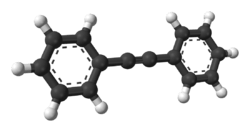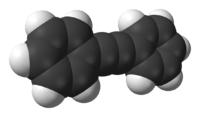Diphenylacetylene
 | |
 | |
 | |
| Names | |
|---|---|
| IUPAC name
2-phenylethynylbenzene | |
| Other names
Tolan Diphenylacetylene 1,2-diphenylethyne | |
| Identifiers | |
| 501-65-5 | |
| 3D model (Jmol) | Interactive image |
| ChEBI | CHEBI:51579 |
| ChEMBL | ChEMBL223309 |
| ChemSpider | 9961 |
| ECHA InfoCard | 100.007.206 |
| PubChem | 10390 |
| |
| |
| Properties | |
| C14H10 | |
| Molar mass | 178.24 g/mol |
| Appearance | colorless solid |
| Density | 0.990 g cm−3, solid |
| Melting point | 62.5 °C (144.5 °F; 335.6 K) |
| Boiling point | 170 °C (338 °F; 443 K) at 19 mmHg |
| insoluble | |
| Structure | |
| sp2 and sp at carbon | |
| 0 D | |
| Hazards | |
| Safety data sheet | Oxford MSDS |
| Related compounds | |
| Related compounds |
C2Me2 Dimethylacetylenedicarboxylate |
| Except where otherwise noted, data are given for materials in their standard state (at 25 °C [77 °F], 100 kPa). | |
| | |
| Infobox references | |
Diphenylacetylene is the chemical compound C6H5C≡CC6H5. The molecule consists of phenyl groups attached to both ends of an alkyne. It is a colorless crystalline material that is widely used as a building block in organic synthesis and as a ligand in organometallic chemistry.
Preparation
Several preparations for this compound exist:
- benzil is condensed with hydrazine to give the bis(hydrazone), which is oxidized with mercury oxide.[1]
- stilbene is brominated, then dehydrohalogenated,[2] but the product can be contaminated with stilbene, which is difficult to remove.[1]
- One method starts from iodobenzene and the copper salt of phenylacetylene in the Castro-Stephens coupling
Interesting derivatives
- Reaction of Ph2C2 with tetraphenylcyclopentadienone results in the formation of hexaphenylbenzene.[3]
- Reaction of Ph2C2 with benzal chloride in the presence of potassium t-butoxide affords the 3-alkoxycyclopropene which coverts to the cyclopropenium ion.[4]
References
- 1 2 Cope, A. C.; Smith, D. S.; Cotter, R. J. "Diphenylacetylene". Org. Synth.; Coll. Vol., 4, p. 377
- ↑ Lee Irvin Smith and M. M. Falkof. "Diphenylacetylene". Org. Synth.; Coll. Vol., 3, p. 350
- ↑ Fieser, L. F. "Hexaphenylbenzene". Org. Synth.; Coll. Vol., 5, p. 604
- ↑ Xu, R. Breslow, R. "1,2,3-Triphenylcyclopropendium Bromide". Org. Synth.; Coll. Vol., 9, p. 730
This article is issued from Wikipedia - version of the 7/15/2015. The text is available under the Creative Commons Attribution/Share Alike but additional terms may apply for the media files.